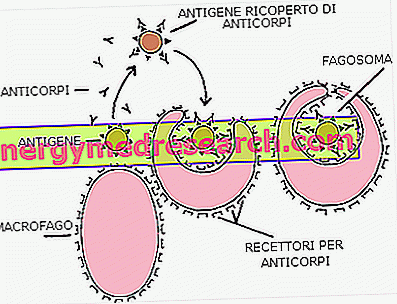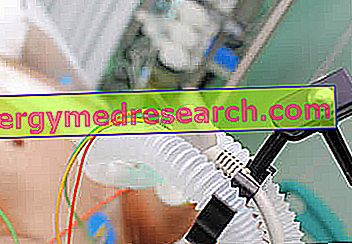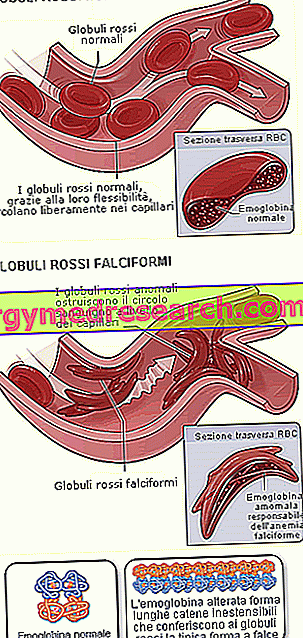Swollen ankles means abnormal thickening of the soft tissues surrounding the malleoli of the feet.
In addition to a simple blemish, sometimes ankle swelling can be the result of more serious dysfunction.

The physiological or pathological mechanisms that determine the ankle swelling are:
- Water retention and edema.
- Reactions to the bite or sting of animals and contact with toxic plants.
- Allergic reactions.
- Trauma.
- Rheumatic diseases.
What to do
- The first thing to do is contact your doctor.
For information, let us try to understand what circumstances or mechanisms may determine ankle swelling.
- In the absence of pain and redness, swollen ankles are probably the result of a non-inflammatory edematous form. Edema is the stagnation of fluids in interstitial spaces. It could be caused by:
- Alteration of the composition of body fluids (plasma and interstices). This can happen in the presence of:
- Serious diseases: pathologies of the metabolism (gout, diabetic lymphedema, etc.), liver failure, kidney failure and heart failure. The resolution of swollen ankles, although generally of secondary importance, occurs with the pharmacological compensation of the disease (or with surgery).
- Hormonal imbalances, such as thyroid hormones, estrogens, progesterone, etc. Some are transient (as in the climacteric syndrome), others are definitive (for example hypothyroidism). Most can be treated with specific medications.
- Sodium abuse: sodium has a very strong osmotic power and can accumulate in interstitial fluids retaining a lot of water (swelling). The only solution is a combination of a low-sodium diet and improved circulation.
- Use of calcium antagonist drugs: these antihypertensive molecules can cause edematous swelling of the ankles. If the extent of the swelling is excessive, the doctor may choose to change the drug therapy.
- Edema caused primarily by vascular diseases, especially venous return. At the level of the lower limbs, when the flow of blood does not return correctly, a stagnation of liquids occurs which accumulate in the ankles. They are particularly subject to this phenomenon: the elderly, the obese, sedentary and pregnant women. To combat this adverse reaction you need:
- In case of overweight, lose weight.
- Increase the level of physical activity.
- Practice draining massages.
- Facilitate drainage by placing the legs on higher body cushions.
- In the presence of other clinical signs, make sure that a vascular thrombus is not involved.
- In the presence of pain accompanied by a worsening of joint mobility (also of other joints) it may be necessary to carry out specific investigations for rheumatic diseases (eg rheumatoid arthritis). The main methods are: radiographs, magnetic resonances, genetic analyzes, blood measurement of inflammation, etc.
- If the outcome is positive, start a specific therapy (drugs, physiotherapy, infiltrations, etc., different depending on the disease).
- Swollen ankles can be the result of a bite or bite caused by animals, or contact with a toxic plant. In this case, it is necessary to apply a specific drug and / or contact the emergency room.
- Equally obvious is the swelling of an ankle due to an infection. Following the infection of a wound it can swell a lot.
- Another possible cause is allergic reactions; in this case, remission varies according to gravity. When the symptoms become systemic it is necessary to use an antihistamine product and contact the emergency service immediately.
- The most frequent cause of swollen ankles is trauma (contusion, distortion, fracture, tendonitis, etc.). Then:
- Perform an x-ray to check for any bone fractures. In case of positivity, the ankle will be immobilized and cold packs will be applied.
- Perform an ultrasound scan to check for tendon and ligament injuries. In case of positivity, the ankle could be wrapped more or less rigidly. Sometimes, the therapy involves the application of hot packs, tecar therapy, CO 2 laser therapy etc.
- In case of bruising, cold packs and anti-inflammatory ointments are sufficient.
What NOT to do
- Ignore the symptom in the doubt that it may be a complication of a serious illness.
- Do not carry out investigations for: metabolic diseases, rheumatic diseases, complications of hepato-renal function, cardiac changes, hormonal imbalances, etc.
- Do not take specific medications for diseases responsible for swollen ankles.
- Do not follow the therapies aimed at recovering injuries (tecar, laser, etc.).
- Follow a sodium-rich diet.
- Do not tell your doctor if swollen ankles have appeared after starting a drug therapy against hypertension.
- Become or stay overweight.
- Become or remain sedentary.
- Disregard self-massage and leg positioning practices.
- Expose yourself to the bite or sting of animals, or contact with toxic plants and do not apply specific ointments.
- Expose yourself to allergizing factors and, after contact, do not take specific drugs or do not go to the emergency department.
- After an injury, in doubt of an infection, do not medicate it and / or take the prescribed antibiotics.
- Neglecting traumas, whatever they may be.
What to eat
Diet can be an important factor in counteracting swollen ankles.
However, this only concerns cases where the nutritional aspect plays a primary role on the triggering mechanism:
- A valid recommendation in all cases, except for some serious diseases, is to increase water intake. Often the edema is worsened by dehydration, which causes the slowing down of renal filtration and indirectly increases the concentration of waste, toxins and sodium.
- Follow a diet low in sodium and rich in potassium. Potassium is the main intracellular cation while sodium is extracellular. An excess of sodium or a lack of potassium creates the displacement of fluids from inside to outside the cells. Furthermore, the right amount of potassium positively affects the metabolic regulation of sodium. Let's not forget that taking certain drugs against hypertension (diuretics) an increase in potassium excretion occurs.
- Follow a diet low in additives and other "useless" molecules that can exert an osmotic effect.
- In case of type 2 diabetes mellitus, follow a specific diet trying to control your blood sugar.
- In the case of gout, try to avoid foods that are richer in purines in excessive amounts (even if nowadays drugs are able to compensate for the illness without the need for large nutritional restrictions).
- In case of impairment of liver and kidney function, follow the specific diet.
- In the case of climacteric syndrome, increase the consumption of foods containing phytosterols (phytoestrogens); these help compensate for transient hormonal variation.
- In the case of inflammatory diseases (eg rheumatoid arthritis), increase the intake of foods containing anti-inflammatory molecules: omega 3, vitamin A, vitamin C, vitamin E, zinc, selenium and polyphenolic substances (simple phenols, flavonoids, tannins) .
Ultimately we recommend:
- For everyone (especially those on a diet rich in food additives): prefer fresh food.
- For those who take too much sodium:
- Prefer foods without sodium glutamate or baking soda.
- To get used to the tasteless taste it is possible to use spices and aromas.
- For diabetics: eat meals with a moderate glycemic load. Foods rich in carbohydrates must have a low glycemic index: whole grains, legumes, little or medium sweet fruits.
- For those with climacteric syndrome: regularly consume soy.
- For those who must increase the omega 3: blue fish, algae, krill oil, some oil seeds and their oils (flax, almonds, kiwi, grape seeds, etc.).
- For those who must increase antioxidants: the aforementioned vitamins and polyphenols are contained mainly in fruits and vegetables. Zinc and selenium in products of animal origin and in dried fruit. Remember that most molecules with biological action can be compromised by temperature. With regard to salts, on the other hand, they tend to disperse especially in the midst of liquids.
What NOT to Eat
- Rich or sodium-based condiments: table salt, soy sauce and other sauces.
- Foods rich in sodium:
- Preserved meat: sausages, seasoned, smoked, canned, etc.
- Bivalve molluscs and preserved fish: clams, mussels, oysters, salted, canned, etc.
- Cheeses.
- Canned legumes and vegetables.
- Packaged snacks and baked goods.
- Fast food in general.
- Sodium bicarbonate.
- Nut or foods rich in sodium glutamate (packaged, Chinese food etc).
- Foods rich in additives: packaged and long-life foods. Snack and colored drinks, flavored, sweetened etc.
- In case of type 2 diabetes mellitus: large portions of foods containing refined flours, syrups and sweet drinks, large portions of very sweet fruit, large portions of potatoes, etc.
- In case of gout: offal, bluefish, bivalve molluscs, dried meat and concentrated sauces etc.
- Spirits: wine, beer, spirits and liqueurs; they are often responsible for impairment of liver function.
Natural Cures and Remedies
- Slimming calorie diet: for overweight individuals, weight reduction is essential in reducing ankle swelling.
- Motor activity: motor activity stimulates blood and lymphatic circulation. Furthermore, it has a direct effect on improving venous return. The contractions cause a shortening and the increase of the muscle section; these, repeatedly pressing against the veins, help to improve the flow of blood contained within them.
- Draining massages: they can be performed by third parties or by the subject himself. In people suffering from poor circulation they can be very useful, provided they are carried out regularly and consistently.
- Position the legs upwards: favors venous return. This practice should be carried out every evening for a considerable time; the same effect can be achieved by placing a rise under the heels throughout the night.
- Choose comfortable shoes and avoid high heels.
- Use compression stockings: by applying pressure from the bottom upwards, they favor venous return.
- Herbalist: all plants and parts of them that improve circulation are suitable. Some are taken as food, others as decoctions or extracts:
- Butcher's broom or butcher's broom.
- Centella asiatica.
- Horse chestnut.
- Witch Hazel.
- Ginkgo biloba.
- Blackberry.
- Currant.
- Red grapevine.
- Topical cosmetics: some over-the-counter products contain anti-inflammatory active ingredients, vasoprotectors, vasodilators, antioxidants, anti-edema, decongestants, etc.
Pharmacological care
The drugs used against swollen ankles are specific for the treatment of primary pathology. This is especially true in the event of trauma, animal bites or bites, inflammatory joint diseases, allergic reactions, infections, etc.
If the swelling is caused by overweight, a sedentary lifestyle, pregnancy or an individual predisposition, there is no specific drug therapy.
Prevention
Prevention of swollen ankles is based on several very different principles depending on the cause:
- Avoid: trauma, bites and animal bites or contact with toxic plants, allergic reactions, infections, etc.
- Treating metabolic diseases and / or compensating for chronic ones.
- Follow a proper diet.
- Avoid overweight.
- Practicing physical activity.
Medical Treatments
There are no specific medical treatments for swelling of the ankles but rather treatments for the diseases from which it may originate.



